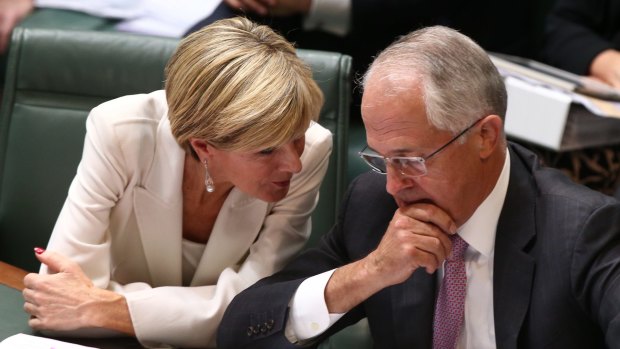By Kelsey Munro
Australia's foreign affairs department has copped lots of criticism for being a digital dinosaur: slow to engage with social media, overly cautious about letting ambassadors blog or tweet, dead boring when it did finally get on Twitter and Facebook. It turns out there's fairly limited demand for tweets of press releases and rigid photos of embassy meeting rooms.
But things are changing, according to British public diplomacy expert Jonathan McClory, whose research in conjunction with Facebook's data team puts Australia in fifth spot internationally in terms of its digital capacity.

Foreign Affairs minister Julie Bishop and Prime Minister Malcolm Turnbull.Credit: Andrew Meares
"Australia is not up there with the British Foreign Office or the [US] State Department on digital diplomacy - with everyone there's room for improvement - but it's operating from a decent place," said Mr McClory, who is in Sydney to speak at the Lowy Institute on Monday on digital diplomacy and the art of the political selfie.
Our smartphone-loving, selfie-shooting, social-media savvy Prime Minister and Foreign Minister - the inventor of emoji-plomacy - haven't hurt, but DFAT is catching up too, he said.
The research was done as part of the Soft Power 30, an index released in July 2015 that ranked 30 countries in terms of soft power resources. Australia finished a respectable sixth overall.
"Malcolm Turnbull - I would say I'm a fan. He's a guy who's proven he gets it on all things digital," McClory said.
Turnbull is a great proponent of the political selfie. But McClory says India's Prime Minister Narendra Modi is the king of the artform.
"One of the things that the Facebook data team found was the Modi effect - if Prime Minister Modi goes and visits a world leader then that world leader will get a boost in the number of likes and people following their Facebook page. He's really good," McClory said.
But beyond the self-promoting social media antics of political leaders, digital diplomacy is important because it gives governments the opportunity to reach people they would struggle to reach otherwise, McClory said, whether to attract foreign students, tourists, or to rally people around a cause. "Australia falls down in that they have a smaller diplomatic network compared to the US or UK, Germany or France, they have to work harder to reach those people."
DFAT leaves individual embassies to manage their own social media outreach, and that has produced uneven results. Many single out Australian ambassador to Indonesia Paul Grigson as an exemplary communicator on social media. The Beijing embassy's Weibo account reaches more than half a million people every day.
Analyst Danielle Cave from the Australian National University, who has been highly critical of DFAT's digital diplomacy in the past, said "digital momentum is building within DFAT and Defence to expand their online presence and reach. However, digital diplomacy is far more than posting information on government managed social media accounts."
"Are there ways Australia could be using mobile apps to leverage our soft power? Are there opportunities to use geo-coding and online mapping to directly connect Asia's growing middle classes with Australian goods and services overseas? Can online publishing platforms (such as blogging) be used by our government to better explain and advocate for Australia's policies and international positions? Many of our peers - who we are also competing with for market and political access - are doing all of the above and more."